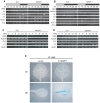Repression of FLOWERING LOCUS T chromatin by functionally redundant histone H3 lysine 4 demethylases in Arabidopsis
- PMID: 19946624
- PMCID: PMC2777508
- DOI: 10.1371/journal.pone.0008033
Repression of FLOWERING LOCUS T chromatin by functionally redundant histone H3 lysine 4 demethylases in Arabidopsis
Abstract
FLOWERING LOCUS T (FT) plays a key role as a mobile floral induction signal that initiates the floral transition. Therefore, precise control of FT expression is critical for the reproductive success of flowering plants. Coexistence of bivalent histone H3 lysine 27 trimethylation (H3K27me3) and H3K4me3 marks at the FT locus and the role of H3K27me3 as a strong FT repression mechanism in Arabidopsis have been reported. However, the role of an active mark, H3K4me3, in FT regulation has not been addressed, nor have the components affecting this mark been identified. Mutations in Arabidopsis thaliana Jumonji4 (AtJmj4) and EARLY FLOWERING6 (ELF6), two Arabidopsis genes encoding Jumonji (Jmj) family proteins, caused FT-dependent, additive early flowering correlated with increased expression of FT mRNA and increased H3K4me3 levels within FT chromatin. Purified recombinant AtJmj4 protein possesses specific demethylase activity for mono-, di-, and trimethylated H3K4. Tagged AtJmj4 and ELF6 proteins associate directly with the FT transcription initiation region, a region where the H3K4me3 levels were increased most significantly in the mutants. Thus, our study demonstrates the roles of AtJmj4 and ELF6 as H3K4 demethylases directly repressing FT chromatin and preventing precocious flowering in Arabidopsis.
Conflict of interest statement
Figures







References
-
- Park DH, Somers DE, Kim YS, Choy YH, Lim HK, et al. Control of circadian rhythms and photoperiodic flowering by the Arabidopsis GIGANTEA gene. Science. 1999;285:1579–1582. - PubMed
-
- Putterill J, Robson F, Lee K, Simon R, Coupland G. The CONSTANS gene of Arabidopsis promotes flowering and encodes a protein showing similarities to zinc finger transcription factors. Cell. 1995;80:847–857. - PubMed
-
- Kobayashi Y, Kaya H, Goto K, Iwabuchi M, Araki T. A pair of related genes with antagonistic roles in mediating flowering signals. Science. 1999;286:1960–1962. - PubMed
-
- Kardailsky I, Shukla VK, Ahn JH, Dagenais N, Christensen SK, et al. Activation tagging of the floral inducer FT. Science. 1999;286:1962–1965. - PubMed
Publication types
MeSH terms
Substances
LinkOut - more resources
Full Text Sources
Other Literature Sources
Molecular Biology Databases

